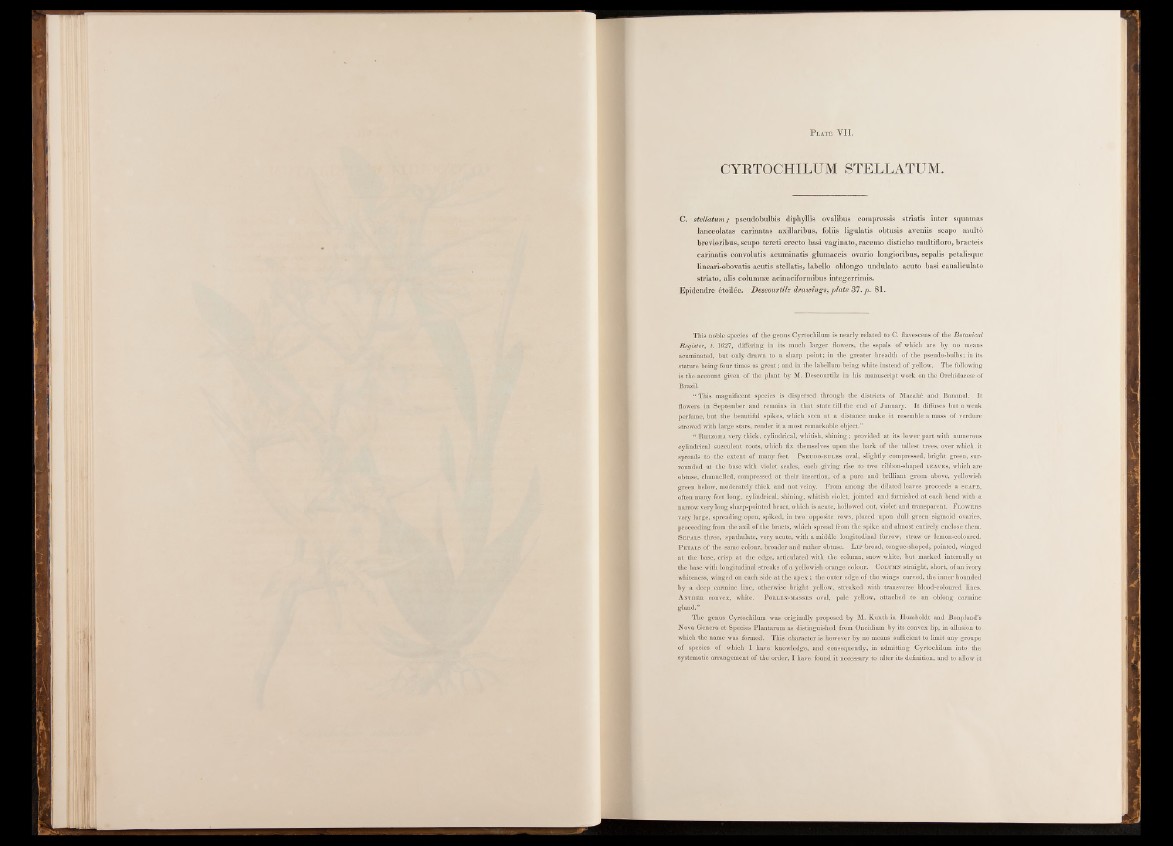
P late VII.
CYRTOCHILUM STELLATUM.
C. stettatum; pseudobulbis diphyllis ovalibus corapressis striatis inter squamas
lanceolatas carinatas axillaribus, foliis ligulatis obtusis aveniis scapo multô
brevioribus, scapo tereti erecto basi vaginato, racemo disticho multifloro, bracteis
carinatis convolutis acuminatis glumaceis ovario longioribus, sepalis petalisque
lineari-obovatis acutis stellatis, labello oblongo undulato acuto basi canaliculato
striato, alis columnæ acinaciformibus integerrimis.
Epidendre étoilée. Descourtilz drawings, plate 37.p. 81.
This noble species of the genus Cyrtochilum is nearly related to C. flavescens of the Botanical
Register, t. 1627, differing in its much larger flowers, the sepals of which are by no means
acuminated, but only drawn to a sharp point; in the greater breadth of the pseudo-bulbs; in its
stature being four times as great; and in the labellum being white instead of yellow. The following
is the account given of the plant by M. Descourtilz in his manuscript work on the Orchidaceae of
Brazil.
“ This magnificent species is dispersed through the districts of Macah6 and Bananal. It
flowers in September and remains in that state till the end of January. It diffuses but a weak
perfume, but the beautiful spikes, which seen at a distance make it resemble a mass of verdure
strewed with large stars, render it a most remarkable object.”
“ R hizoma very thick, cylindrical, whitish, shining; provided at its lower part with numerous
cylindrical succulent roots, which fix themselves upon the bark of the tallest trees, over which it
spreads to the extent of many feet. P seudo-bulbs oval, slightly compressed, bright green, surrounded
at the base with violet scales, each giving rise to two ribbon-shaped leaves, which are
obtuse, channelled, compressed at their insertion, of a pure and brilliant green above, yellowish
green below, moderately thick and not veiny. From among the dilated leaves proceeds a scape,
often many feet long, cylindrical, shining, whitish violet, jointed and furnished at each bend with a
narrow very long sharp-pointed bract, which is acute, hollowed out, violet and transparent. F lowers
very large, spreading open, spiked, in two opposite rows, placed upon dull green sigmoid ovaries,
proceeding from the axil of the bracts, which spread from the spike and almost entirely enclose them.
Sepals three, spathulate, very acute, with a middle longitudinal furrow, straw or lemon-coloured.
P etals of the same colour, broader aud rather obtuse. Lip broad, tongue-shaped, pointed, winged
at the base, crisp at the edge, articulated with the column, snow white, but marked internally at
the base with longitudinal streaks of a yellowish orange colour. Column straight, short, of an ivory
whiteness, winged on each side at the apex; the outer edge of the wings curved, the inner bounded
by a deep carmine line, otherwise bright yellow, streaked with transverse blood-coloured lines.
Anther convex, white. P ollen-masses oval, pale yellow, attached to an oblong carmine
gland.”
The genus Cyrtochilum was originally proposed by M. Kunth in Humboldt and Bonpland’s
Nova Genera et Species Plantarum as distinguished from Oncidium by its convex bp, in allusion to
which the name was formed. This character is however by no means sufficient to limit any groupe
of species of which I have knowledge, and consequently, in admitting Cyrtochilum into the
systematic arrangement of the order, I have found it necessary to alter its definition, and to allow it